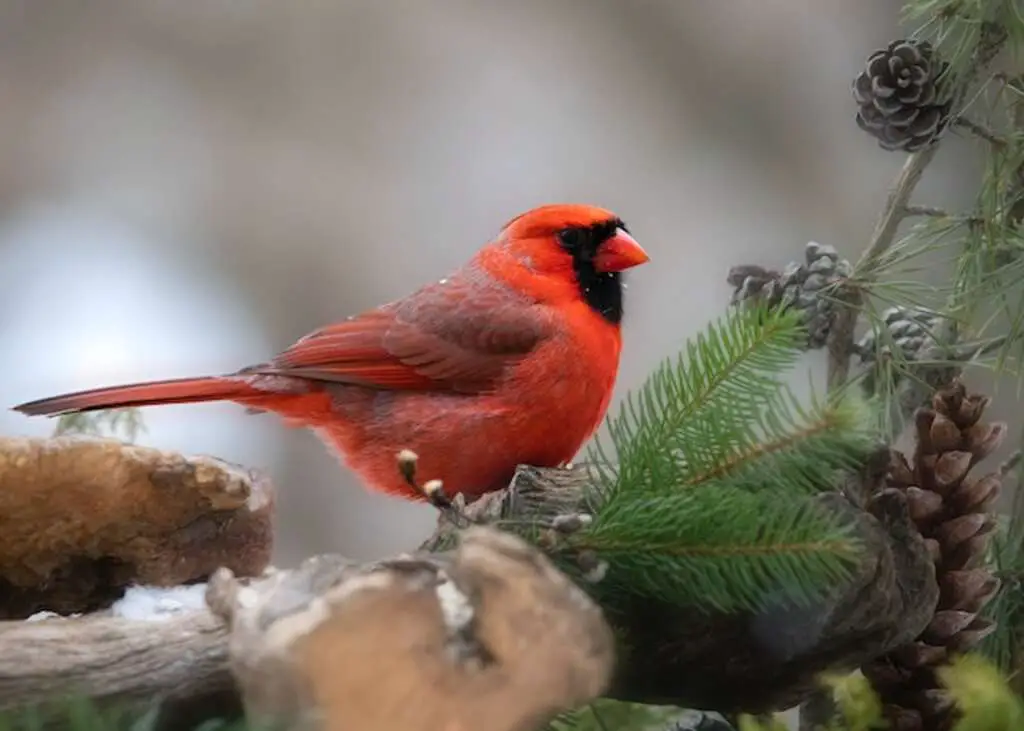
In the vast expanse of North America, where diverse ecosystems intertwine, a creature of vibrant beauty and melodic song thrives – the cardinal.
Where are cardinals found? Cardinals, scientifically known as Cardinalis cardinalis, grace the landscapes from the Eastern to Western United States and even into Central America.
Their striking red plumage against lush greenery captivates the beholder’s gaze.
From dense forests to urban gardens, these charismatic birds make their homes, fascinating researchers and bird enthusiasts alike.
Join us on an exploration of their distribution, behaviors, and the conservation efforts necessary to protect these emblematic creatures who roam freely, enchanting us with their presence.
Table of Contents
- 1 Key Takeaways
- 2 Where Are Cardinals Found
- 3 Overview of Cardinal Characteristics
- 4 Eastern United States
- 5 Southern United States
- 6 Central United States
- 7 Western United States
- 8 Canada
- 9 Mexico
- 10 Central America
- 11 Cardinal Habitats
- 12 Cardinal Behaviors
- 13 Conservation Status and Threats
- 14 How to Attract the Cardinal
- 15 Conclusion
- 16 Frequently Asked Questions
- 16.1 How do cardinals communicate with each other?
- 16.2 What is the lifespan of a cardinal?
- 16.3 Do cardinals migrate during certain seasons?
- 16.4 What is the diet of a cardinal?
- 16.5 Are there any predators that pose a threat to cardinals?
- 16.6 Why are there no cardinals in California?
- 16.7 Do cardinals live in Colorado?
- 16.8 Do cardinals live in Florida?
- 16.9 Do cardinals live in Utah?
- 16.10 Do cardinals live in Denver?
- 16.11 Do cardinals live in Europe?
- 16.12 Does Phoenix have cardinals?
- 17 Author
Key Takeaways
- Cardinals are widely distributed across North America, including the eastern United States, the southern United States, the Midwest and Plains regions, the western United States, Canada, Mexico, and Central America.
- Cardinals can be found in a variety of habitats, including dense forests, urban gardens, woodlands, parks, savannahs, mangroves, and even in human environments such as parks, gardens, and backyards.
- Cardinals are non-migratory in some regions, such as the eastern United States and the Midwest, while in other regions, such as the western United States and Central America, they may undertake seasonal migrations.
- Cardinals face conservation challenges due to habitat loss and fragmentation caused by deforestation and urbanization, and their populations have shown a decline influenced by human factors and climate change. Conservation efforts include the establishment of protected areas and habitat restoration.
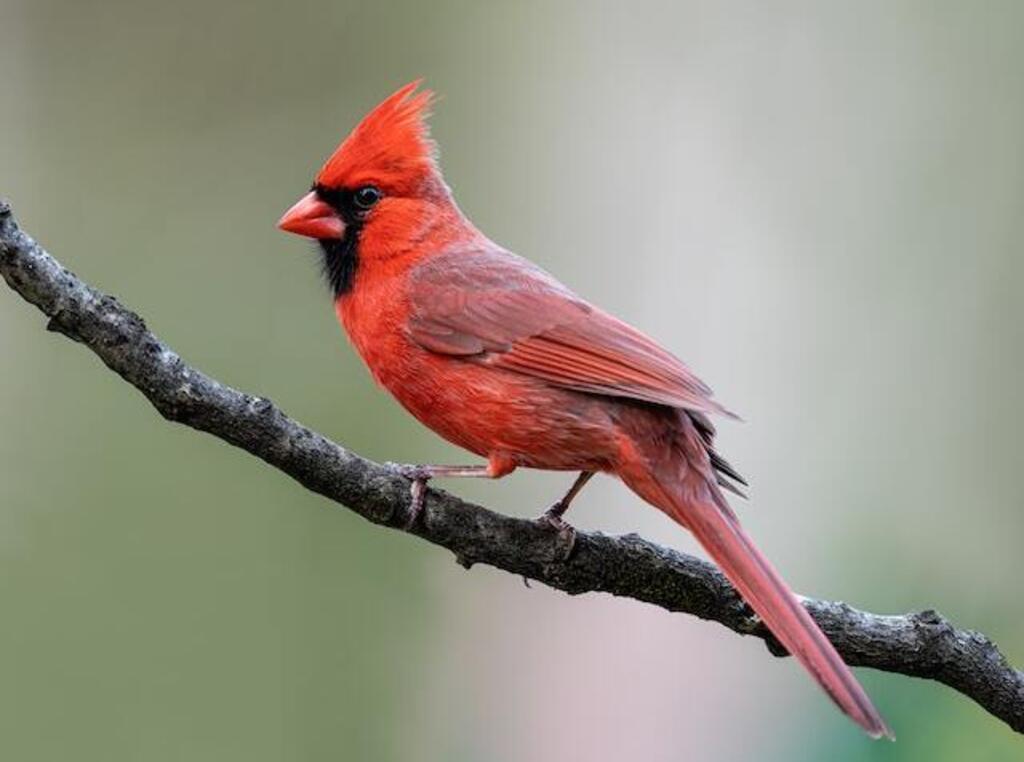
Where Are Cardinals Found
The Cardinal, known for its vibrant red plumage, ranges from Canada to Panama. It inhabits a variety of habitats including woodlands, marshes, deserts, and riverbanks.
Cardinals are commonly spotted in suburban areas due to their affinity for bird feeders. Their striking presence brings joy to bird enthusiasts across North and Central America.
Overview of Cardinal Characteristics
This section provides a comprehensive overview of the key characteristics of cardinals.
Cardinals are medium-sized songbirds that belong to the family Cardinalidae.
They are known for their vibrant plumage, with males displaying bright red feathers and females having a more muted brown coloration.
Cardinals are primarily seed-eaters, but also consume insects and fruits, making their diet versatile.
In terms of breeding patterns, cardinals are monogamous and form pair bonds that last throughout the breeding season.
They build cup-shaped nests made of twigs and grasses, usually hidden within dense shrubs or trees. The female lays 3–4 eggs, which she incubates for about two weeks.
After hatching, both parents participate in feeding the chicks.
Cardinals are commonly found in the eastern United States, where they inhabit a variety of habitats such as woodlands, parks, and gardens.
Eastern United States
The Eastern United States is home to a vibrant population of a distinct red bird that is commonly associated with the Christmas season.
Here is an overview of cardinal migration and breeding patterns in this region:
- Migration: Cardinals in the Eastern United States are mostly non-migratory, meaning they do not travel long distances during seasonal changes. However, some individuals may move short distances depending on food availability and weather conditions.
- Breeding Patterns: Cardinals in this region typically breed from mid-March to mid-August. They build cup-shaped nests in dense shrubs or trees, and the female lays 2–5 eggs. Both parents take turns incubating the eggs and feeding the chicks until they fledge.
- Habitat: Cardinals prefer a mix of open woodlands, thickets, and gardens with plenty of shrubs for nesting and perching. They are adaptable birds and can thrive in urban areas as well.
As we transition to the subsequent section about the Southern United States, let’s explore how cardinal populations differ in this region.
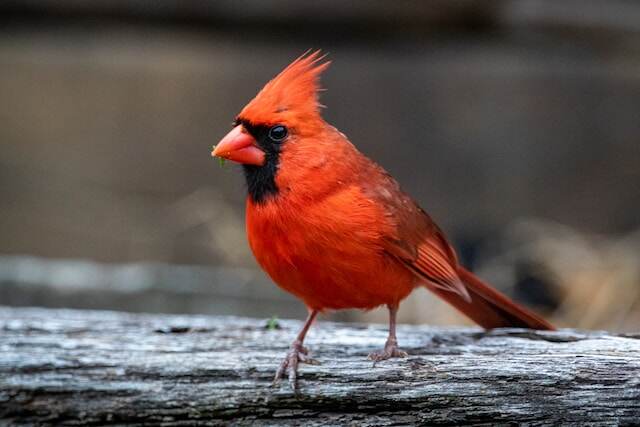
Southern United States
An exploration of the Southern United States reveals distinctive characteristics of cardinal populations in this region.
Cardinals are commonly found in the southern states, including Texas, Louisiana, Mississippi, Alabama, Georgia, Florida, South Carolina, and North Carolina.
These states provide an ideal habitat for cardinals due to their diverse ecosystems, including forests, woodlands, and wetlands.
Cardinals are known to thrive in areas with dense vegetation, as it provides them with ample cover and food sources.
The southern climate, with its mild winters and hot summers, also contributes to the success of cardinal populations in this region.
Interestingly, there has been a noticeable increase in cardinal populations in the southern United States over the past few decades.
This can be attributed to factors such as urbanization, which has created more suitable habitats for cardinals.
Transitioning into the subsequent section about the Central United States, it is important to examine the similarities and differences in cardinal populations in this region.
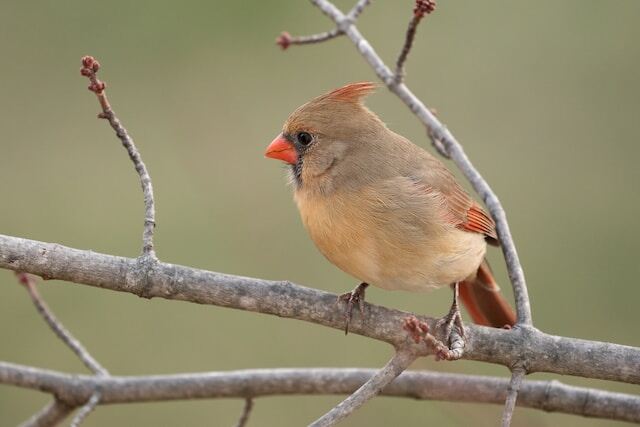
Central United States
The central region of the United States is home to a diverse range of ecosystems that support a variety of bird species, including cardinals.
In the Midwest, cardinals can be found in states such as Illinois, Indiana, and Ohio, where they thrive in both urban and rural areas.
Moving westward into the Plains, cardinals are also present in states like Kansas, Nebraska, and Oklahoma, adapting to the grassland habitats found in this region.
The presence of cardinals in both the Midwest and the Plains highlights their ability to adapt to different environments and their wide distribution across the central United States.
Cardinals in the Midwest
Cardinals, iconic symbols of the Midwest, can be found in abundance amidst the picturesque landscapes of this region.
They thrive in the diverse midwest climate, which ranges from hot summers to cold winters with ample rainfall.
Cardinals are non-migratory birds, meaning they do not undertake long-distance migrations like some other bird species.
Instead, they are known for their short-distance movements within their territory, which can be influenced by factors such as food availability and breeding opportunities.
In the midwest, cardinals can be seen year-round, and their vibrant red plumage contrasts beautifully with the lush greenery of the region.
As we transition to the subsequent section about cardinals in the plains, it is important to note that these resilient birds have adapted well to various habitats and continue to captivate bird enthusiasts with their beauty and melodious songs.
Cardinals in the Plains
Thriving amidst the vast expanse of the Plains, the scarlet plumage of cardinals stands out like a fiery beacon against the backdrop of golden prairies.
These striking birds are found throughout the plains of North America, from the southern tip of Texas to the Canadian border.
The Plains provide an ideal habitat for cardinals, as they prefer open areas with scattered trees and shrubs, which are plentiful in this region.
Cardinals are not migratory birds, meaning they do not undertake long-distance journeys like many other bird species.
Instead, they are year-round residents of the Plains, adapting to the changing seasons and relying on the abundance of plains wildlife for sustenance.
With their vibrant red feathers and beautiful songs, cardinals bring life and color to the vast grasslands of the Plains.
Moving on to the western United States…
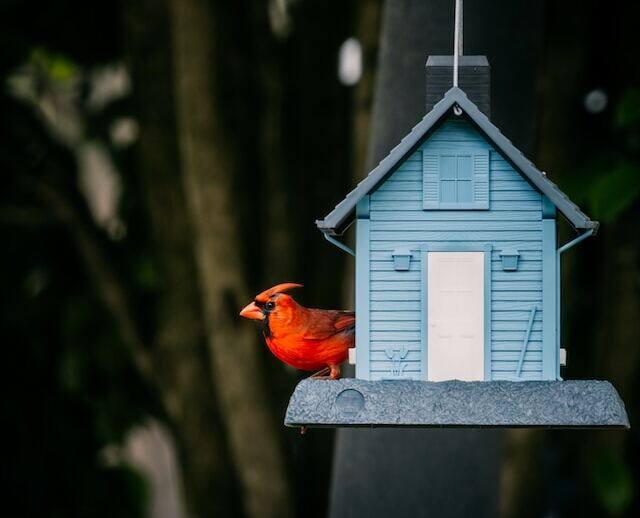
Western United States
Nestled within the vast expanse of the Western United States, there exists a habitat where cardinals gracefully inhabit.
This region is particularly known for its western cardinal sightings and the intricate migration patterns these birds follow.
To delve deeper into the subject, let’s explore two key aspects:
Western Cardinal Sightings:
- The Western United States offers ample opportunities for bird enthusiasts to observe cardinals in their natural habitat.
- States such as California, Arizona, and New Mexico boast significant cardinal populations, attracting birdwatchers from far and wide.
Migration Patterns:
- Cardinals in the Western United States exhibit fascinating migration patterns.
- Some cardinals residing in this region are year-round residents, while others undertake seasonal migrations to escape harsh weather conditions.
Transitioning to the subsequent section about Canada, it is worth noting that cardinals also appear in other parts of North America, including our northern neighbor.
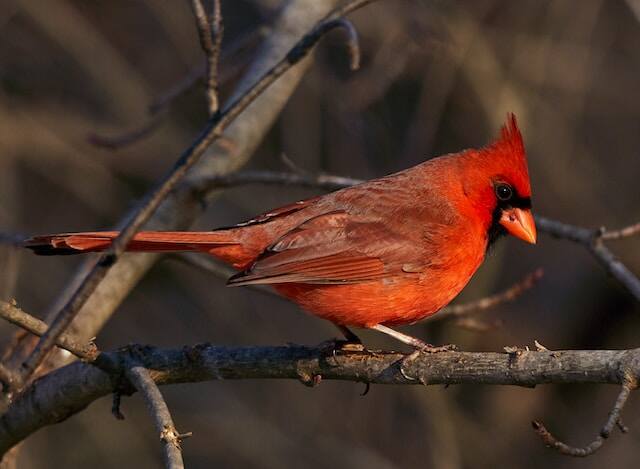
Canada
Canada, being located in North America, is home to a diverse range of avian species, including the vibrant and iconic cardinal.
Cardinals are primarily found in the southern regions of Canada, particularly in the provinces of Ontario, Quebec, and the Maritimes.
These birds prefer habitats with dense shrubs and trees, such as forests, woodlands, and gardens.
They are known to thrive in both urban and rural environments, making them adaptable to a variety of landscapes.
The cardinal’s bright red plumage stands out against the snowy Canadian winters, making it a beloved sight for birdwatchers and nature enthusiasts.
Cardinals are known for their melodic songs, which contribute to the rich biodiversity of Canada’s avian population.
Transitioning to the subsequent section about Mexico, it is important to explore the southern range of the cardinal’s habitat.

Mexico
The southern range of the cardinal’s habitat extends into Mexico, where it continues to contribute to the diverse avian population of the region.
Cardinal migration patterns in Mexico are influenced by seasonal changes and availability of food sources.
During the breeding season, cardinals establish territories and build nests in dense vegetation, such as shrubs and thickets, where they lay their eggs.
The male cardinal is known for its vibrant red plumage, which is used to attract a mate. Once the eggs hatch, both parents take turns feeding and caring for the chicks.
The availability of suitable habitat and food resources in Mexico allows cardinals to thrive and maintain stable populations.
Moving forward to the subsequent section about ‘central america’, it is important to further explore the range of the cardinal and its impact on the avian community in this region.
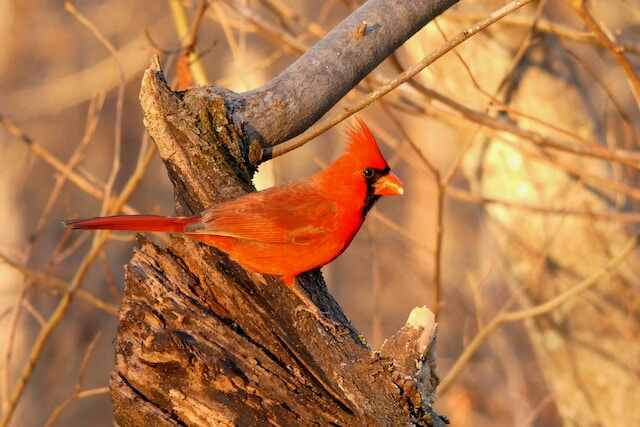
Central America
Cardinals are also found in Central America, specifically in countries like Belize and Costa Rica.
In Belize, cardinals can be found in various habitats including forests, savannahs, and mangroves. They are known for their vibrant red plumage and can often be spotted perched on tree branches or foraging on the ground.
Similarly, in Costa Rica, cardinals can be found in forests and gardens, where they feed on a variety of seeds and fruits. Their presence in these countries adds to the rich avian diversity of Central America.
Cardinals in Belize
Nestled in the heart of Central America lies a vibrant haven where diverse ecosystems welcome the occasional vagrant sightings of cardinals, adding a touch of allure to the local avifauna.
Belize, with its varied habitats, becomes an unexpected stopover during the cardinal migration, offering temporary refuge and resources.
These enchanting birds, adorned with striking red plumage, embark on remarkable journeys, occasionally straying from their usual range and gracing Belize with their presence.
While these vagrant sightings are not part of the cardinals’ regular distribution in Belize, they serve as a testament to the unpredictable nature of avian migration.
The ecological significance of cardinals extends beyond their beauty, as they play a crucial role in seed dispersal and regulation of pest populations by feeding on fruits, insects, and spiders.
As we delve into the fascinating world of cardinals in Central America, we gain a deeper appreciation for the wonders of their lives and the ever-surprising encounters they bring.
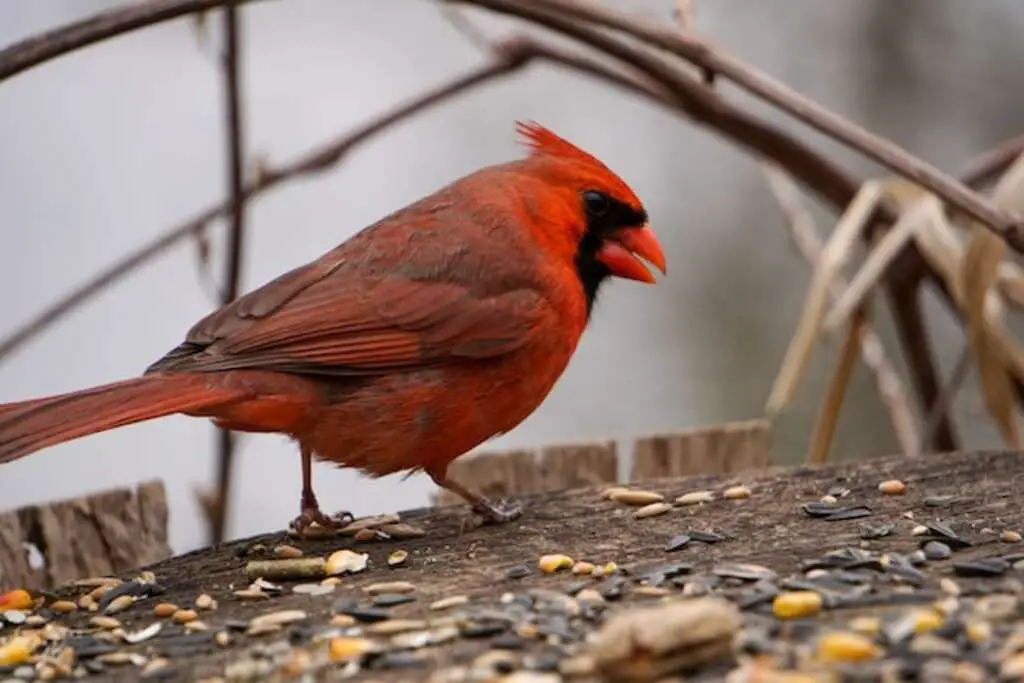
Cardinal Habitats
Cardinals, known for their vibrant red plumage, can be found in a variety of habitats. In forests, cardinals thrive in dense vegetation, utilizing the cover and resources provided by the trees.
They are often found in the understory, where they forage for food and build their nests.
In urban areas, cardinals have adapted to human environments, making use of parks, gardens, and backyard feeders as their habitats.
Despite the differences in these habitats, cardinals have shown remarkable flexibility in their ability to adapt and thrive in various settings.
Cardinals in forests
In forested habitats, one may find the presence of cardinals, a type of bird known for its vibrant plumage. Cardinals can be found in various types of forests, including rainforests and deciduous forests.
In rainforests, cardinals are often found in the understory, where they take advantage of the dense vegetation for cover and foraging opportunities.
They prefer areas with a mix of trees, shrubs, and vines, providing them with a diverse range of food sources.
In deciduous forests, cardinals can be found in both the understory and the canopy, using the trees and shrubs as perching sites and for nesting.
They are adaptable birds and can thrive in different forest environments as long as there is suitable vegetation and food availability.
Cardinals in forests play a crucial role in seed dispersal and insect control. Moving on to cardinals in urban areas, they have also managed to adapt to human-altered environments.
Cardinals in urban areas
Urban areas provide a unique habitat for cardinals, as they have successfully adapted to human-altered environments.
In recent years, urban birdwatching has gained popularity, and cardinals are frequently spotted in urban parks, gardens, and even backyards.
These vibrant birds are known for their striking red plumage, which stands out against the concrete jungle.
Urban wildlife management practices, such as creating green spaces and providing bird feeders, have helped attract cardinals to urban areas.
Cardinals are known to build their nests in shrubs and trees found in urban landscapes, and their diet primarily consists of seeds, fruits, and insects.
Despite the urban setting, cardinals still exhibit their characteristic behaviors, including their melodious songs and territorial displays.
Transitioning into the subsequent section about cardinal behaviors, these urban habitats offer a fascinating insight into the adaptability and resilience of these remarkable birds.
Cardinal Behaviors
One fascinating aspect of cardinal behaviors is their ability to communicate through a wide range of vocalizations and body movements.
Cardinals use different vocalizations to convey various messages, such as warning calls to alert others of potential danger or songs to attract mates.
They also engage in elaborate courtship displays, including head-bobbing, wing-flashing, and hopping.
In terms of nesting habits, cardinals typically build their nests in dense vegetation, often within shrubs or thickets.
The female is responsible for constructing the nest using twigs, grass, and leaves, while the male assists by providing materials.
When it comes to feeding patterns, cardinals are primarily granivorous, meaning they primarily consume seeds.
However, they also eat fruits, insects, and spiders, particularly during the breeding season when they need additional protein.
Understanding these cardinal behaviors is crucial for conservation efforts and addressing threats to their populations.
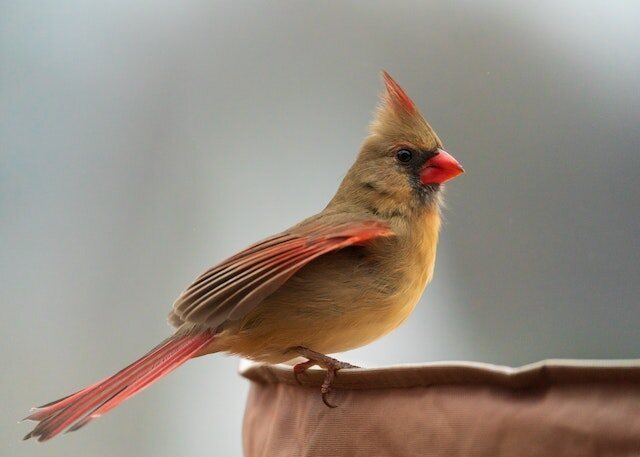
Conservation Status and Threats
The conservation status of cardinals is of concern due to several factors. Population trends of cardinals have shown a decline in recent years, mainly due to habitat loss and fragmentation.
Human impacts such as deforestation and urbanization have greatly affected their natural habitats, leading to a decrease in their numbers.
Conservation efforts are being made to mitigate these threats, including the establishment of protected areas and the restoration of suitable habitats for cardinals.
Population trends
Contrary to popular belief, population trends of cardinals have been subject to small fluctuations over the years.
While there has been a general population decline observed in some regions, it is important to note that this decline may not be solely attributed to human factors.
Climate change impacts, such as extreme weather events and habitat loss, have also played a significant role in shaping the population trends of cardinals.
Understanding these factors is crucial for conservation efforts aimed at protecting this iconic species. To evoke emotion in the audience, consider the following:
1) The alarming decrease in cardinal populations highlights the urgent need for conservation measures.
2) Climate change-induced habitat loss threatens the survival of cardinals, a loss that would leave a void in the natural world.
3) The decline of cardinals serves as a stark reminder of the fragility of our ecosystems and the urgent need for collective action.
Transitioning into the subsequent section about ‘human impacts and conservation efforts,’ it becomes evident that addressing these challenges requires a multi-faceted approach that encompasses both scientific research and active conservation initiatives.
Human impacts and conservation efforts
Addressing the challenges posed by human impacts and implementing effective conservation efforts necessitates a comprehensive approach that incorporates extensive scientific research and proactive initiatives.
| Human Impacts | Conservation Efforts |
|---|---|
| Deforestation | Reforestation and habitat restoration |
| Climate change | Reduction of carbon emissions and promotion of sustainable practices |
| Pollution | Implementation of stricter regulations and waste management systems |
| Urbanization | Creation of protected areas and urban green spaces |
These conservation efforts aim to mitigate the negative consequences of human impacts on cardinal populations.
By restoring habitats, reducing carbon emissions, improving waste management, and creating protected areas, we can provide cardinals with suitable environments and protect them from further decline.
Scientific research and proactive initiatives are essential in guiding these efforts and ensuring the long-term survival of these beautiful birds.
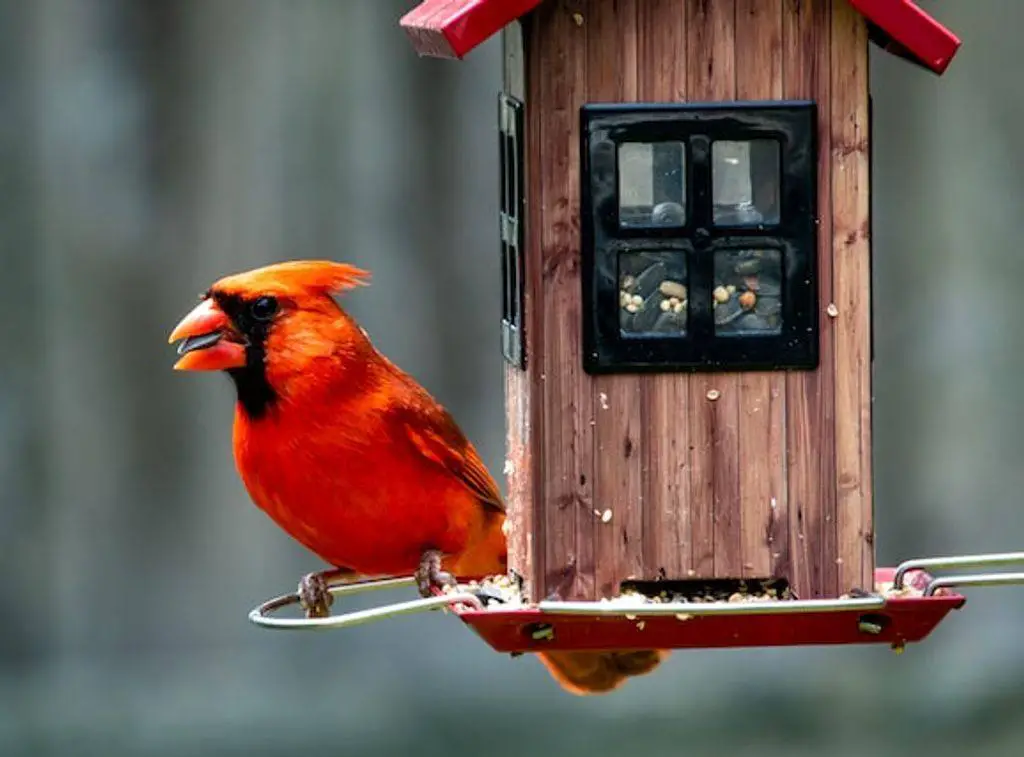
How to Attract the Cardinal
It’s a common sight to see Northern Cardinals perched on trees, singing their song. They are one of the most well-known birds in North America and can be found throughout the United States, Canada, and Mexico. The northern cardinal is also one of the easiest species to attract to your backyard with these 11 simple tips.
- 1) Offer them a bird feeder that has a mix of seeds and nuts, with sunflower seeds and peanuts being their favorite. If you’re searching for a quality feeder that you won’t have to keep filling every couple of days, then I would recommend this squirrel-proof feeder on Amazon. Read more here: 10 Best Bird Feeders for Cardinals
- 2) Provide water for them in containers such as birdbaths, or large pet dishes because they love taking baths in cold water like people do!
- 3) The best way to attract these beautiful creatures is by having lots of trees around your home with fruit bearing branches near them.
- 4) Plant nectar bearing plants such as honeysuckle, lilac, lilies, hibiscus, marigolds, tulips, and daffodils, and apple trees in your yard. Next, make sure there are plenty of natural sources of food such as berries or fruits that can be found year round.
- 5) Put out feeders filled with seeds such as black oil sunflower seed or mixed birdseed. They have a special liking for sunflower seeds, but they also like peanut butter, raisins, dried corn and other foods that can be used in their feeders.
- 6) Put up a suet feeder or hanging platform feeder filled with these suet cakes peanuts, apples, or other treats that the birds like to eat.
- 7) Place nest boxes or hollow logs near your feeders.
- 8) Plant a variety of native plants such as goldenrod, bee balm, and butterfly weed.
- 9) Plant shrubs like service berry, or an azalea bush and bushes around the edges of your property, so there’s plenty of cover from above as well as below ground level.
- 10) Place feeders near windows so that they can be seen from inside your home while you enjoy them outside.
- 11) Plant some berries and bushes like raspberry bushes, blueberry bushes, elderberry bushes, and hawthorn.
Conclusion
The Cardinal, known for its vibrant plumage and distinctive crest, is a bird species found primarily in North and Central America.
Cardinals inhabit a variety of habitats, including forests, shrublands, and gardens, throughout their range.
They are known for their strong territorial behavior and their melodious songs, which are used for communication and mate attraction.
Despite their widespread distribution, Cardinals face threats such as habitat loss and predation.
Conservation efforts are crucial to ensure the continued survival of this iconic bird.
In conclusion, the Cardinal’s beauty and resilience make it a captivating species, serving as a symbol of the diverse avian life found in the Americas.

Frequently Asked Questions
How do cardinals communicate with each other?
Cardinals communicate with each other through a repertoire of vocalizations and body language. Their melodic songs and distinctive calls serve as a means of attracting mates, defending territories, and establishing social hierarchies. Breeding habits and territoriality play a crucial role in their communication dynamics.
What is the lifespan of a cardinal?
The lifespan of a cardinal can vary depending on various factors. On average, they live for about 3 to 5 years. However, factors such as predation, diseases, and habitat quality can influence their lifespan.
Do cardinals migrate during certain seasons?
Cardinals exhibit migratory patterns, with most individuals migrating during specific seasons. They typically migrate from northern regions to more southern areas. However, climate change has been observed to impact their migration patterns and timing.
What is the diet of a cardinal?
Cardinal feeding habits are primarily seed-based, with a preference for fruits, insects, and grains. Their diet preferences include sunflower seeds, berries, and beetles. Cardinals have also been observed consuming spiders, snails, and tree sap as supplementary food sources.
Are there any predators that pose a threat to cardinals?
Predators such as cats, snakes, and birds of prey pose a threat to cardinals. Cardinals build their nests in shrubs and trees, providing some protection from ground predators.
Why are there no cardinals in California?
Northern Cardinals, although absent from the Northern half of California, do grace the southern region year-round after being introduced there. Their non-native status explains their limited distribution within the state, but southern California residents can still enjoy the vibrant presence of these cardinals in their surroundings.
Do cardinals live in Colorado?
While cardinals are not native to Colorado and are considered rare in the state, there have been occasional sightings of vagrant cardinals. Although uncommon, these rare occurrences have been documented in Colorado.
Do cardinals live in Florida?
Undoubtedly, Northern Cardinals find Florida to be a welcoming abode throughout the year, as they thrive in the southeastern reaches of the state. Their vibrant plumage and lively demeanor make a significant contribution to the diverse avian community that flourishes in Florida’s ecosystem.
Do cardinals live in Utah?
Although not native to Utah and not regular residents, Cardinals have been sporadically observed in the state, as evidenced by documented sightings. Their occasional appearances add an element of excitement for birdwatchers and enthusiasts in Utah.
Do cardinals live in Denver?
While Cardinals have established a presence in Denver and other parts of eastern Colorado, their occurrence in the area remains relatively uncommon.
Do cardinals live in Europe?
Regrettably, Cardinals do not reside in Europe. Their natural habitat spans the eastern United States, reaching as far west as South Dakota and Texas. Originally prevalent in the southeast, they have gradually expanded northward, even colonizing parts of southeastern Canada.
Does Phoenix have cardinals?
While cardinals are not native to Utah and are not considered regular residents, occasional records indicate their presence as transient visitors in the state. Although not a common sight, Utah may occasionally witness the passing through of these vibrant cardinals on their migratory journeys.

